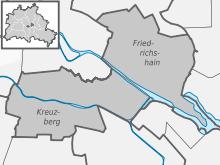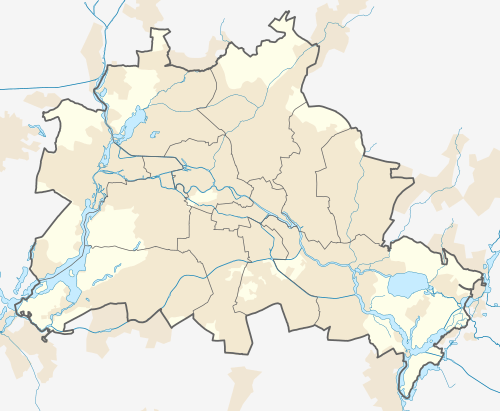Friedrichshain-Kreuzberg
Friedrichshain-Kreuzberg is the second borough of Berlin, formed in 2001 by merging the former East Berlin borough of Friedrichshain and the former West Berlin borough of Kreuzberg. The historic Oberbaum Bridge, formerly a Berlin border crossing for pedestrians, links both districts across the river Spree as the new borough's landmark (as featured in the coat of arms).

Friedrichshain-Kreuzberg | |
|---|---|
Borough of Berlin | |
 Coat of arms | |
Location of Friedrichshain-Kreuzberg in Berlin .svg.png) | |
 Friedrichshain-Kreuzberg  Friedrichshain-Kreuzberg | |
| Coordinates: 52°30′N 13°27′E | |
| Country | Germany |
| State | Berlin |
| City | Berlin |
| Subdivisions | 2 localities |
| Government | |
| • Mayor | Monika Herrmann (Alliance '90/The Greens) |
| Area | |
| • Total | 20.16 km2 (7.78 sq mi) |
| Population (2012-11-30) | |
| • Total | 278,579 |
| • Density | 14,000/km2 (36,000/sq mi) |
| Time zone | CET/CEST (UTC+1/+2) |
| Vehicle registration | B |
| Website | official homepage |
The counterculture tradition especially of Kreuzberg led to a plurality of votes for the Green Party, which is unique among all Berlin boroughs. The local MP Hans-Christian Ströbele is the only Green politician directly elected to the federal Bundestag. While Kreuzberg is characterised by a high number of immigrants, the share of non-German citizens in Friedrichshain is much lower and the average age is higher. The merger between the distinct quarters is celebrated by an annual anarchic "vegetable fight" on the Oberbaumbrücke. Both parts have to deal with the consequences of gentrification.
Subdivision
Friedrichshain-Kreuzberg is divided into 2 localities, Friedrichshain and Kreuzberg.
Politics
.svg.png)
As of May 2018, the following parties were represented on the borough council:[1]
- Alliance '90/The Greens 20
- The Left 12
- SPD 10
- CDU 4
- Die PARTEI 4
- Alternative for Germany 3
- Free Democratic Party 2
International relations
Twin towns – Sister cities
Friedrichshain-Kreuzberg is twinned with:
|
See also
- Berlin Friedrichshain-Kreuzberg - Prenzlauer Berg East (electoral constituency)
References
- "Factions of the Friedrichshain-Kreuzberg borough council". Retrieved 7 May 2018.
- "Wiesbaden's international city relations". Retrieved 24 December 2012.
- "Kontakty partnerskie Miasta Szczecin". Urząd Miasta Szczecin (in Polish). Archived from the original on 2012-08-18. Retrieved 2013-07-29.